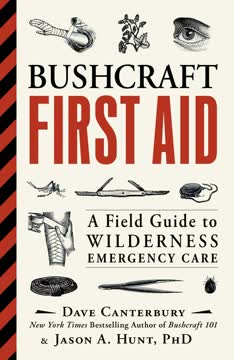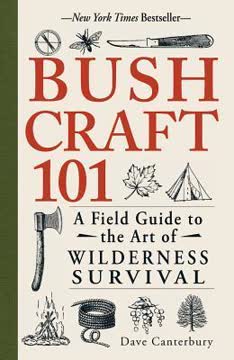Key Takeaways
1. Prioritize Prevention and Preparation for Wilderness First Aid
The best treatment is prevention!
Planning is Paramount. Before venturing into the wilderness, develop a detailed emergency plan, inform someone of your itinerary, and establish a buddy system. Understanding the local environment, weather patterns, and potential hazards is crucial for minimizing risks.
Essential Gear. Equip yourself with the "Ten Cs"—cutting tool, combustion device, container, cordage, cover, cotton material, candling device, compass, cargo tape, and combination tool—to address various emergencies. A well-stocked first-aid kit tailored to the specific environment and activities is also essential.
Self-Aid First. Prioritize self-aid as the cornerstone of your first-aid training. Being able to care for yourself ensures you can also assist others and prevents you from becoming a burden in an emergency situation.
2. Master Basic Survival Skills for Wilderness Emergencies
Fire can mean the difference between life and death in an emergency situation.
Fire Mastery. Practice fire-starting techniques to create a sustainable fire in under five minutes, crucial for warmth, water purification, and signaling. Tinder selection, bird's nest construction, and sure-fire fire starters are essential skills.
Shelter Construction. Learn to build a five-minute shelter using emergency blankets or improvised materials to protect against the elements. A well-constructed shelter can prevent hypothermia, hyperthermia, and exposure.
Water Purification. Master the five-minute water boil technique to ensure access to potable water for drinking and wound irrigation. Boiling water effectively eliminates harmful bacteria and pathogens.
3. Assess the Emergency Scene Methodically and Prioritize Care
Losing your calm is the worst thing you could do as it may lead to you making poor decisions or feeling as if you can’t act at all.
Scene Safety. Upon approaching an injured person, prioritize your safety by surveying the scene for hazards such as falling rocks, unstable terrain, or dangerous animals. Ensure the environment is safe before administering first aid.
Triage and Assessment. In multiple-casualty situations, use triage to prioritize treatment based on the severity of injuries. Assess the injured person's level of responsiveness (AVPU), airway, breathing, and circulation (ABCs) to identify life-threatening conditions.
Physical Examination. Conduct a thorough physical exam, starting from the head and working down the body, to identify all injuries. Use the DCAP-BTLS system (Deformities, Contusions, Abrasions, Punctures, Burns, Tenderness, Lacerations, Swelling) to guide your assessment.
4. Control Bleeding and Treat Wounds with Available Resources
The main goal in treating any bleeding injury is to stop the bleeding.
Direct Pressure. Apply direct pressure to the wound using a clean cloth or improvised dressing to control bleeding. Elevate the injured limb above the heart to further reduce blood flow.
Wound Cleaning. Irrigate the wound with clean water to remove debris and prevent infection. Use soap to wash around the wound, but avoid harsh disinfectants like alcohol or peroxide.
Bandaging and Dressing. Cover the wound with a sterile dressing and secure it with a bandage. Improvise bandages using cloth strips, cargo tape, or other available materials.
5. Manage Common Wilderness Injuries: Blisters, Burns, and Bone Trauma
Pain is inevitable. Suffering is optional.
Blister Prevention. Prevent blisters by ensuring proper boot fit, using padding, wearing moisture-wicking socks, and applying tape to friction-prone areas. Treat blisters by sterilizing a needle, draining the fluid, and covering with a bandage.
Burn Treatment. Cool burns immediately with clean water. Classify burns based on severity (superficial, partial-thickness, full-thickness) and apply appropriate dressings. Seek medical attention for burns covering more than 5% of the body.
Bone and Joint Injuries. Stabilize fractures and dislocations by splinting the injured limb. Improvise splints using branches, cargo tape, and padding. Treat sprains and strains with RICE (Rest, Ice, Compression, Elevation).
6. Address Circulatory and Respiratory Issues Promptly
All truly great thoughts are conceived while walking.
Shock Management. Recognize the signs of shock (rapid pulse, cool skin, altered mental status) and treat by maintaining a clear airway, elevating the legs, keeping the person warm, and providing reassurance.
Breathing Difficulties. Assist individuals with asthma by helping them use their inhaler and positioning them for optimal breathing. Treat hyperventilation by encouraging slow, deep breaths.
Heart Attack Recognition. Recognize the signs of a heart attack (chest pain, shortness of breath, nausea) and assist the person in taking their prescribed medication. Evacuate immediately for professional medical care.
7. Recognize and Respond to Neurological and Abdominal Emergencies
Take care of your body. It’s the only place you have to live in.
Stroke Identification. Use the FAST acronym (Face drooping, Arm weakness, Speech difficulty, Time to call for help) to identify stroke symptoms. Evacuate immediately and position the person with the paralyzed side down.
Seizure Management. Protect individuals experiencing seizures by moving them to a safe area and preventing injury. Do not restrain them or put anything in their mouth. Monitor their breathing and provide reassurance after the seizure.
Abdominal Injuries. Suspect internal abdominal injuries with pain, tenderness, rigidity, or swelling. Do not give food or drink. Treat for shock and evacuate immediately.
8. Handle Urinary, Reproductive, Acute, and Chronic Illnesses in the Wild
It is health that is real wealth and not pieces of gold and silver.
Urinary Issues. Encourage hydration and consumption of acidic fluids for urinary tract infections. Seek medical attention if symptoms persist or worsen.
Menstrual and Pregnancy Issues. Manage heavy menstrual bleeding with rest and fluids. Seek immediate medical attention for bleeding during pregnancy, as it may indicate a miscarriage or ectopic pregnancy.
Chronic Illnesses. Ensure individuals with chronic conditions like diabetes have adequate supplies of medication and snacks. Be prepared to manage hypoglycemia and hyperglycemia.
9. Mitigate Environmental Hazards: Heat, Cold, and Altitude
People need to be cautious because anything built by man can be destroyed by Mother Nature.
Hypothermia Prevention. Dress in layers, stay dry, and seek shelter to prevent hypothermia. Treat hypothermia by removing wet clothing, providing warm blankets, and administering warm fluids.
Heat-Related Illnesses. Avoid overexertion in hot weather, stay hydrated, and seek shade to prevent heat exhaustion and heat stroke. Treat heat stroke by cooling the person down with water or cold packs and evacuating immediately.
Altitude Sickness. Ascend gradually to allow for acclimatization to high altitudes. Treat altitude sickness by descending to a lower elevation, resting, and staying hydrated.
10. Identify and Treat Insect and Animal Bites Effectively
In my life outdoors, I’ve observed that animals of almost any variety will stand in a windy place rather than in a protected, windless area infested with biting insects. They would rather be annoyed by the wind than bitten.
Insect Bite Prevention. Wear long sleeves and pants, use insect repellent, and avoid areas with high insect populations.
Spider Bite Treatment. Clean spider bites with soap and water and apply cold packs. Seek medical attention for bites from venomous spiders like black widows or brown recluses.
Tick Bite Removal. Remove ticks carefully with tweezers, grasping close to the skin. Clean the bite area and monitor for signs of Lyme disease or Rocky Mountain spotted fever.
11. Recognize and Avoid Poisonous Plants
Poison is in everything, and no thing is without poison. The dosage makes it either a poison or a remedy.
Plant Identification. Learn to identify poison ivy, poison oak, and poison sumac. Remember the saying, "Leaves of three, let it be," for poison ivy and oak.
Contact Prevention. Wear protective clothing and avoid touching unknown plants. Wash skin immediately after potential exposure with soap and water or an alcohol-based cleaner.
Reaction Treatment. Apply calamine lotion or other anti-itch creams to relieve symptoms of contact dermatitis. Seek medical attention for severe reactions or infections.
12. Utilize Plant Medicine for Common Wilderness Ailments
You know what they call alternative medicine that’s been proved to work? Medicine.
Herbal Knowledge. Familiarize yourself with common medicinal plants in your area and their uses. Learn to identify plants by their taste, habitat, and physical characteristics.
Tissue State Treatment. Understand the five tissue states (dry, cold, wind, hot, wet) and select plants with appropriate properties to address imbalances.
Herbal Preparations. Master basic herbal preparations such as poultices, infusions, decoctions, and tinctures to extract and administer medicinal compounds.
Last updated:
FAQ
1. What is "Bushcraft First Aid: A Field Guide to Wilderness Emergency Care" by Dave Canterbury about?
- Wilderness First Aid Focus: The book is a comprehensive guide to treating injuries and illnesses in the wilderness, emphasizing practical, improvised solutions when professional medical help is far away.
- Bushcraft and Self-Reliance: It integrates bushcraft skills with first aid, teaching readers how to use both modern gear and natural resources for emergency care.
- Step-by-Step Guidance: The book covers everything from planning and prevention to assessment, treatment, and evacuation in outdoor emergencies.
- Unique Approach: Unlike standard first aid manuals, it focuses on what the typical outdoors person actually carries and how to improvise with the Ten Cs and local plants.
2. Why should I read "Bushcraft First Aid" by Dave Canterbury?
- Essential for Outdoor Enthusiasts: If you hike, camp, hunt, or spend time in remote areas, this book prepares you for medical emergencies when help is not immediately available.
- Improvisational Skills: It teaches how to use common bushcraft tools and natural materials for first aid, which is crucial when standard supplies run out or are unavailable.
- Confidence and Preparedness: The book helps you stay calm, make effective decisions, and manage stress in high-pressure situations.
- Comprehensive Coverage: It addresses a wide range of scenarios, from minor cuts to life-threatening injuries, environmental hazards, and even plant-based remedies.
3. What are the key takeaways from "Bushcraft First Aid" by Dave Canterbury?
- Preparation is Prevention: Planning, knowing your limits, and carrying the right gear (the Ten Cs) are the best ways to avoid emergencies.
- Improvisation is Key: Learn to adapt and use what’s available—both in your pack and in nature—for first aid.
- Calm Assessment Saves Lives: Systematic scene assessment, prioritizing treatment, and ongoing monitoring are critical in wilderness emergencies.
- Nature as Medicine: The book provides detailed guidance on identifying and using medicinal plants for common ailments and injuries.
4. What are the Ten Cs in "Bushcraft First Aid" and how do they relate to wilderness emergency care?
- Core Survival Tools: The Ten Cs are essential items every outdoors person should carry: Cutting tool, Combustion device, Container, Cordage, Cover, Cotton material, Candling device, Compass, Cargo tape, and Combination tool.
- First Five are Critical: The first five (knife, fire starter, container, cordage, cover) are hardest to improvise and most vital for survival and first aid.
- First Aid Applications: These items can be used to create splints, tourniquets, bandages, shelters, and to boil water for wound cleaning.
- Comfort and Versatility: The remaining five add comfort and versatility, enabling you to improvise dressings, signal for help, and work in low-light conditions.
5. How does "Bushcraft First Aid" by Dave Canterbury recommend handling the initial emergency scene and patient assessment?
- Scene Safety First: Always assess the environment for hazards before approaching an injured person to avoid becoming a victim yourself.
- Systematic Approach: Use the AVPU scale (Alert, Verbal, Painful, Unresponsive) to assess responsiveness, then check ABCs (Airway, Breathing, Circulation).
- Physical Exam: Conduct a head-to-toe exam, looking for DCAP-BTLS (Deformities, Contusions, Abrasions, Punctures, Burns, Tenderness, Lacerations, Swelling).
- Ongoing Monitoring: Reassess vital signs and ABCs regularly, especially if the patient’s condition is serious or changing.
6. What are the most common wilderness injuries and illnesses covered in "Bushcraft First Aid" and how should they be treated?
- Bleeding and Wounds: Stop bleeding with direct pressure, clean wounds with boiled or clean water, and improvise dressings from available materials.
- Fractures and Sprains: Immobilize with splints made from sticks and cloth, use RICE (Rest, Ice, Compression, Elevation) for sprains, and avoid moving the patient unless necessary.
- Burns and Blisters: Cool burns with water, use dry or moist dressings as appropriate, and treat blisters by draining and protecting them.
- Environmental Hazards: Address hypothermia, heat exhaustion, dehydration, and altitude sickness with shelter, hydration, and gradual acclimatization.
7. How does "Bushcraft First Aid" by Dave Canterbury address infection prevention and the use of natural remedies?
- Cleanliness is Critical: Wash hands, wounds, and utensils with clean water or wood ash to prevent infection.
- Natural Disinfectants: Use pine sap, plantain, and other plant-based remedies as antiseptics when commercial products are unavailable.
- Recognizing Infection: Watch for redness, heat, swelling, and red streaks; treat with hot soaks and herbal poultices if necessary.
- Medicinal Plants: The book details how to identify, harvest, and prepare local plants for treating wounds, burns, digestive issues, and more.
8. What is the role of stress management and teamwork in wilderness emergencies according to "Bushcraft First Aid"?
- Stay Calm and Focused: Managing your own stress and projecting calm helps prevent panic and poor decisions.
- Team Roles: Assign clear roles—one person leads, others assist with treatment, evacuation, or calming the group.
- Communication: Keep the injured person informed and involved in their care to reduce anxiety and improve cooperation.
- Practice Scenarios: The book includes practical scenarios to illustrate effective teamwork and stress management in action.
9. How does "Bushcraft First Aid" by Dave Canterbury recommend improvising first aid tools and supplies in the wild?
- Use What’s Available: Improvise gloves from plastic bags, dressings from bandannas or T-shirts, and splints from sticks or gear.
- Ten Cs in Action: Cargo tape (like Gorilla Tape) can make butterfly bandages, secure splints, or create pressure dressings.
- Natural Materials: Use plant leaves (mullein, yarrow) as gauze, cattail fluff for padding, and wood ash for cleaning.
- Adapt to the Situation: The book emphasizes creativity and adaptability, with step-by-step instructions for making do with limited resources.
10. What are the key legal and ethical considerations in wilderness first aid as discussed in "Bushcraft First Aid"?
- Good Samaritan Laws: Generally protect those who provide aid in good faith, but laws vary by state and country.
- Consent and Communication: Always ask for permission to help if the person is conscious; if unresponsive, consent is assumed.
- Do No Harm: Only provide care within your level of training and avoid actions that could worsen the injury.
- Obligation to Stay: Once you begin care, remain with the patient until relieved by someone with equal or greater training, unless your own safety is at risk.
11. How does "Bushcraft First Aid" by Dave Canterbury integrate plant medicine and herbal remedies into wilderness emergency care?
- Tissue State Approach: The book teaches how to match plant properties (astringent, mucilaginous, anti-inflammatory, etc.) to specific types of injuries or illnesses.
- Common Medicinal Plants: Detailed profiles and uses for plants like yarrow, plantain, willow, jewelweed, and more are provided for treating wounds, burns, digestive issues, and infections.
- Preparation Methods: Instructions for making poultices, infusions, decoctions, tinctures, and salves from wild plants are included.
- Safety and Identification: Emphasizes correct plant identification and cautions against using unknown species.
12. What are the best quotes from "Bushcraft First Aid" by Dave Canterbury and what do they mean?
- “The best treatment is prevention!” – Emphasizes the importance of preparation, planning, and risk reduction in wilderness safety.
- “As big as your head, or your fire is dead.” – A practical tip for building a bird’s nest of tinder large enough to reliably start a fire, crucial for warmth and first aid.
- “You never know when you may become lost or stranded, and with the invaluable skills taught by the Pathfinder System, you can survive an emergency situation.” – Highlights the unpredictability of the outdoors and the value of self-reliance.
- “If you cannot properly care for yourself, why would you think you could care for someone else?” – Stresses the foundational importance of self-aid skills before helping others.
- “Poison is in everything, and no thing is without poison. The dosage makes it either a poison or a remedy.” (Paracelsus) – Reminds readers that even natural remedies must be used with knowledge and care.
Review Summary
Bushcraft First Aid receives positive reviews for its comprehensive wilderness emergency care information. Readers appreciate the combination of modern first aid and traditional herbal healing methods, practical scenarios, and plant identification photos. The book is praised for its organization, easy referencing, and focus on survival without typical first aid supplies. Some reviewers note it's not for beginners and wish for more emphasis on correct plant identification. Overall, it's considered a valuable resource for outdoor enthusiasts and those interested in wilderness first aid.
Similar Books
Download PDF
Download EPUB
.epub digital book format is ideal for reading ebooks on phones, tablets, and e-readers.












